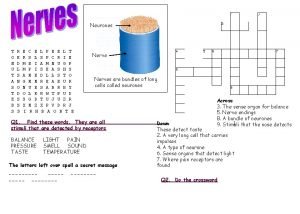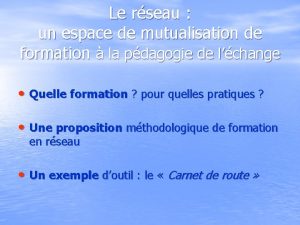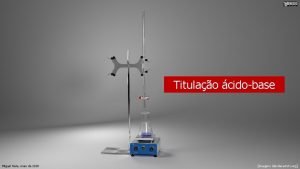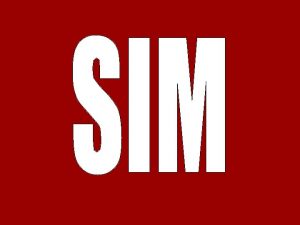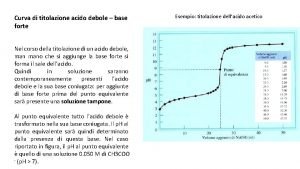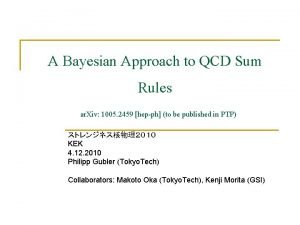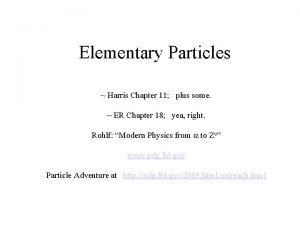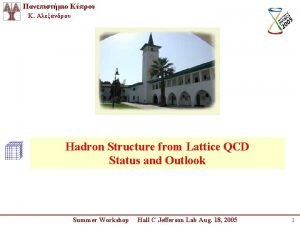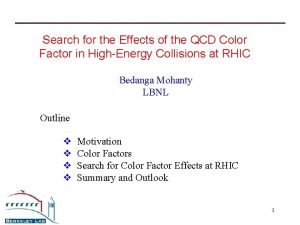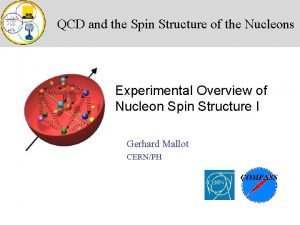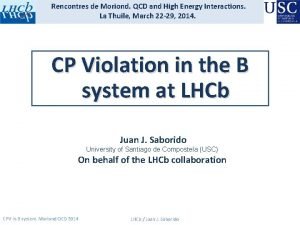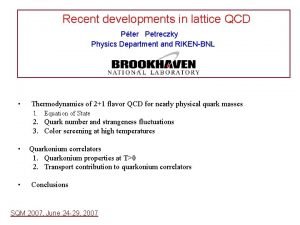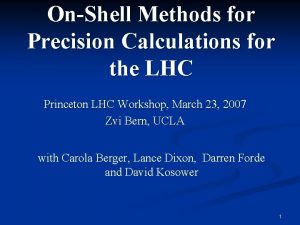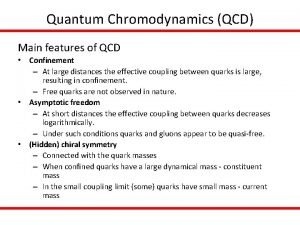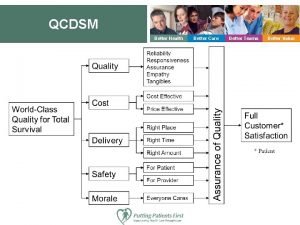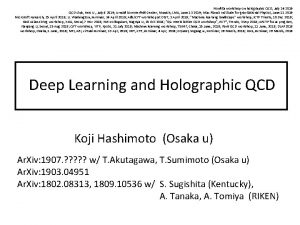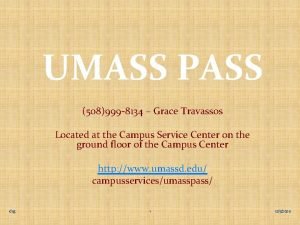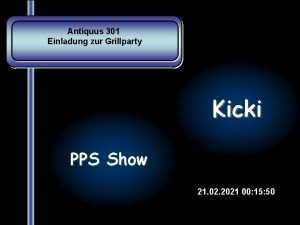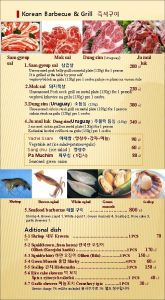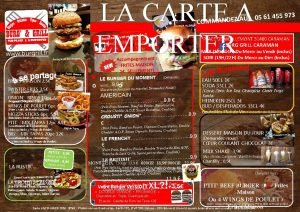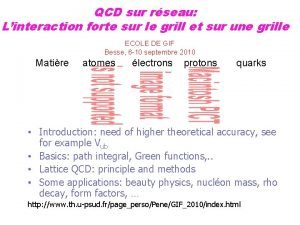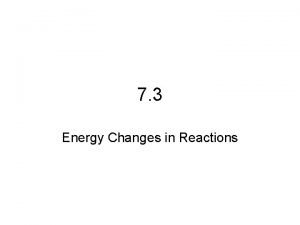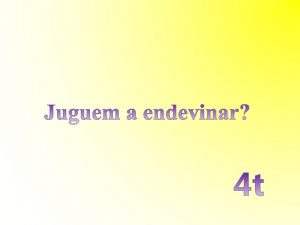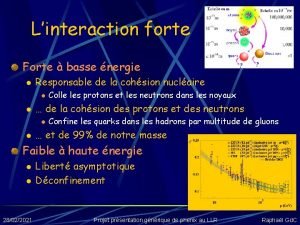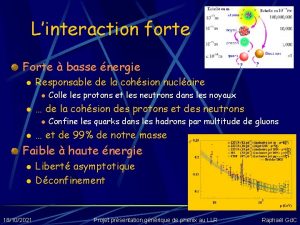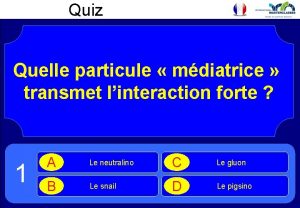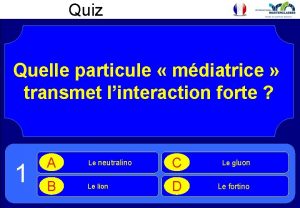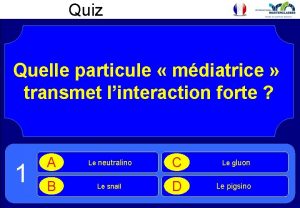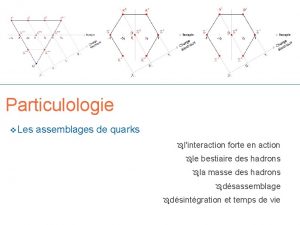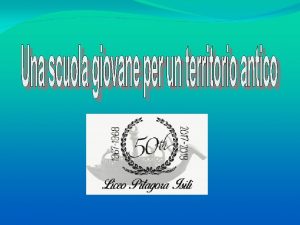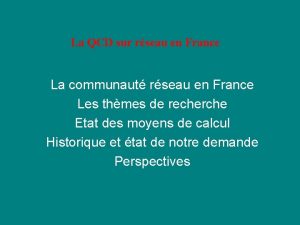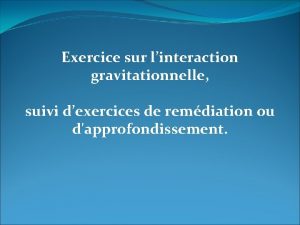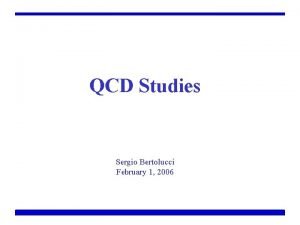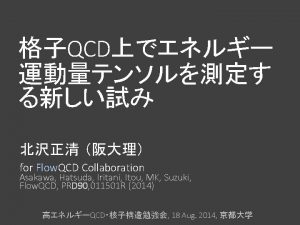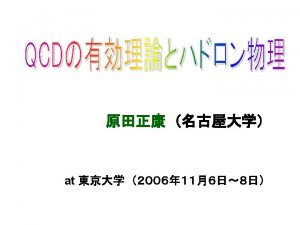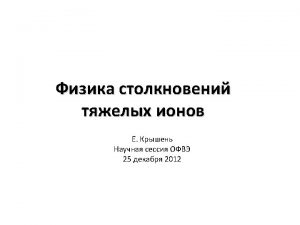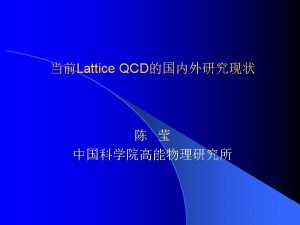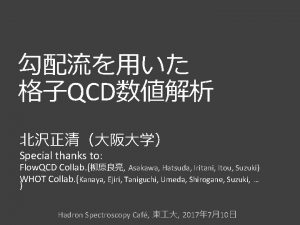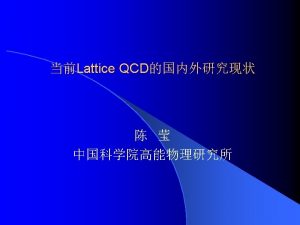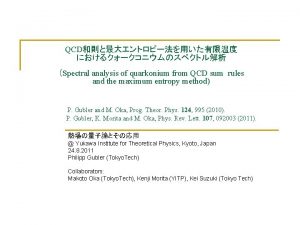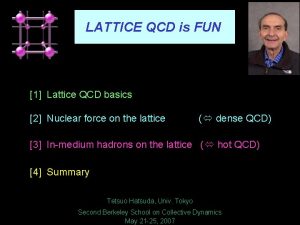QCD sur rseau Linteraction forte sur le grill














![Continuation to imaginary time t =-i , exp[i SG] exp[- SG] SG is positive, Continuation to imaginary time t =-i , exp[i SG] exp[- SG] SG is positive,](https://slidetodoc.com/presentation_image/646c94b7feea5037715022db1a9f6365/image-15.jpg)





![QCD path integral: ∫DU exp[ (-6/g 2) SG[U]] f. Det[Mf] O / ∫exp[ (-6/g QCD path integral: ∫DU exp[ (-6/g 2) SG[U]] f. Det[Mf] O / ∫exp[ (-6/g](https://slidetodoc.com/presentation_image/646c94b7feea5037715022db1a9f6365/image-21.jpg)
![Monte-Carlo method d. Uexp[ (-6/g 2) SG[U]] f. Det[Mf ] O ______________________________ d. Uexp[ Monte-Carlo method d. Uexp[ (-6/g 2) SG[U]] f. Det[Mf ] O ______________________________ d. Uexp[](https://slidetodoc.com/presentation_image/646c94b7feea5037715022db1a9f6365/image-22.jpg)








- Slides: 30

QCD sur réseau: L’interaction forte sur le grill et sur une grille ECOLE DE GIF Besse, 6 -10 septembre 2010 Matière atomes électrons protons quarks • Introduction: need of higher theoretical accuracy, see for example Vub • Basics: path integral, Green functions, . . • Lattice QCD: principle and methods • Some applications: beauty physics, nucléon mass, rho decay, form factors, … http: //www. th. u-psud. fr/page_perso/Pene/GIF_2010/index. html

Fundamental Particles + Higgs boson, to be discovered; at LHC ?

QCD: Theory of the strong subnuclear interaction How do quarks and gluons combine to build-up protons, neutrons, pions and other hadrons. Hadronic matter represents 99% of the visible matter of universe How do protons and neutrons combine to Build-up atomic nuclei ?

During the 60’s, understanding strong interactions seemed to be an insurmountable challenge ! and yet, … Beginning of the 70’s QCD was discovered and very fast confirmed by experiment. It was discovered thanks to asymptotic freedom: strong interaction is not always so strong A splendid scientific epic.

An astounding consequence of QCD Confinement One never observes isolated quarks neither gluons. They only exist in bound states, hadrons (color singlets) made up of: three quarks or three anti-quarks, the (anti-)baryons, example: the proton, neutron, lambda, …. one quark and one anti-quark, mésons, example: the pion, kaon, B, the J/psi, . . confinement has not yet been derived from QCD Image: we pull afar two heavy quarks, a strong « string » binds them (linear potential). At som point the string breaks, a quark-antiquark pair jumps out of the vacuum to produce two mesons. You never have separated quarks and antiquarks. Imagine you do the same with the electron and proton of H atom. The force is less and at some point e and pare separated (ionisation).

Cross section e+e- hadrons (PDG) Im(T )

Green functions, a couple of examples Quark propagator (non gauge-invariant) S(x, y) is a 12 x 12 matrix (spin x color) current-current Green function 2 2 y où T is gauge-invariant. Im{T } related to the (e+e- hadrons) total cross-section

Strong interaction is omnipresent It explains: Hadrons structure and masses The properties of atomic nuclei The « form factors » of hadrons (ex: p+e -> p+e) The final states of p+e -> e+ hadrons (pions, nucleons…) The products of high energy collisions: e- e+ -> hadrons (beaucoup de hadrons) The products of pp-> X (hadrons) Heavy ions collisions (Au + Au -> X), new states of matter (quark gluon plasmas) And all which includes heavier quarks (s, c, b, t): the path from experiment to CKM matrix elements needs an accurate knowledge of QCD effects ……….

QCD’s Dynamics : Lagrangien Three « colors » a kind of generalised charge related to the « gauge group» SU(3). Action: SQCD=∫d 4 x LQCD(x) On every space-time point: 3(colors)x 6(u, d, s, c, b, t) quarks/antiquark fields [Dirac spinors] q(x) and 8 real gluon fields [Lorentz vectors] A a(x) L = -1/4 Ga µ + i∑ - µ j i i f q f µ (D )ij q f -mf q fq if Where a=1, 8 gluon colors, i, j=1, 3 quark colors, F=1, 6 quark flavors, µ Lorentz indices Gaµ = ∂µAa - ∂ Aaµ + gfabc Ab µ Ac (D µ)ij = ij ∂µ - i g aij /2 Aaµ fabc is SU(3)’s structure constant, aij are Gell-Mann matrices t q = q 0 - The Lagrangian of QED is obtained from the same formulae after withdrawing color indices a, b, c, i, j; fabc 0 et aij /2 1 The major difference is the gluon-gluon interaction

Apology of QCD Prototype of a « beautiful theory» : Newton’s A « beautiful theory » contains an input precise and condensed, principles, postulates, free parameters (QCD: simple Lagrangian of quarks and gluons, 7 parameters). � A very rich output, many physical observables (QCD: millions of experiments implying hundreds of « hadrons » : baryons, mesons, nuclei). QCD is noticeable by the unequated number and variety of its « outputs » Confinement : « input » speaks about a few quarks and gluons, et la « output » , hundred’s of hadrons, of nuclei. This metamorphosis is presumably the reason of that rich variety of « outputs » . BUT the accuracy of the predictions is rather low

What to compute and how ? What objects are we intérested in ? Green functions What formula allows to compute them ? Path integral How to tame path integral ? Continuation to imaginary time Discretization of space-time

Path integral Dirac (1933) Feynman (1948): the Schrödinger equation’s Green functions can be expressed in terms of « path integral » . This enhances the space-time symmetry. It is generalisable to quantum field theories. It provides the basis for the grand synthesis of the 70’s which unified quantum field theory with the statistical field theory of a fluctuating field near a second-order phase transition. To see later R. P. Feynman

Path intégral (example of 4 theory) In a generic quantum field theory, the vacuum expectation value of an operator O is given by Is a generic bosonic field The action S[ ] is: The « i » in the exponential accounts for quantum interferences between paths. Extremely painful numerically For example the propagator of the particle « » is given by: - The path integral of a fermion wih an action d 4 xd 4 y (x)M(x, y) (y) given by Det[M] is

Path intégral (example of 4 theory) In a generic quantum field theory, the vacuum expectation value of an operator O is given by Is a generic bosonic field The action S[ ] is: The « i » in the exponential accounts for quantum interferences between paths. Extremely painful numerically For example the propagator of the particle « » is given by: - The path integral of a fermion wih an action d 4 xd 4 y (x)M(x, y) (y) given by Det[M] is
![Continuation to imaginary time t i expi SG exp SG SG is positive Continuation to imaginary time t =-i , exp[i SG] exp[- SG] SG is positive,](https://slidetodoc.com/presentation_image/646c94b7feea5037715022db1a9f6365/image-15.jpg)
Continuation to imaginary time t =-i , exp[i SG] exp[- SG] SG is positive, exp[- SG] is a probability distribution <O> = ∫DU O exp[- SG] f. Det[Mf]/ ∫DU exp[- SG] f. Det[Mf] Is a Boltzman distribution in 4 dimensions: exp[- SG] exp[- H] The passage to imaginary time has turned the quantum field theory into a classical thermodynamic theory at equilibrium. The metric becomes Euclidian possible hypercubic discretization Once the Green functions computed with imaginary time, one must return to the quantum field theory, one must perform an analytic continuation in the complex variable faire t or p 0. Using the analytic properties of quantum field theory. Simple case, the propagator in time of a particle of energy E: t: real time : imaginary time Maupertuis (1744) Maintenant, voici ce principe, si sage, si digne de l'Être suprême lorsqu'il arrive quelque changement dans la Nature, la quantité d'Action employée pour ce changement est toujours la plus petite qu'il soit possible. »

Here it comes The lattice

Lattice QCD Transformation de jauge: q(x) g(x)q(x) A field configuration {U }is a set of SU(3) matrices U (x) one per link. a is the length of the link, ≤ 0. 1 fm The quarks on the sites The spatial volume > (2 - 3 fm)3 Lattice of 323 x 64(time): 8 106 matrices U (x); 150 106 real numbers. There exists many different actions, converging towards QCD when a 0, with converging predictions for physics.

LATTICE QCD +: rigorous method, as many parameters than in QCD (nf+1), controle of statistical errors and of systematic uncertainties, wide domain of application (perturbative and non perturbative), very rich pannel of applications. Ken Wilson -: Heavy numerical methode, limited to systems with few particles, limited accuracy.

There exists several actions for the gauge (gluon) fields. The first one was Wilson’s action: Wilson action for gluons There exists many more actions for the quarks fields

. Quark Action Reminder - (x, y)q(y) is the discretised Dirac operator, matrix 12 N q(x)M f Reminder of Dirac operator in the continuum: Mf(x, y)= i [ ij( x+ y x- y a - i g 0 ∑a aij Aa ] - m ij; It depends on gluon fields i, j =1, 3 Reminder: Integrating the quarks fields gives f. Det[Mf({U})], Mf depending on the field configuration {U} On the lattice, the most important possible discretization of Dirac operator • Naive quarks (but 16 quarks instead of 1) • Wilson quarks (but strong breaking of chiral symmetry) • Staggered (Kogut Susskind) (but the continuum limit is controversial) • Domain Wall (good chiral beheaviour - costly) • Overlap (Neuberger) (very good chiral beheaviour - costly) • etc The quark propagator from x to y is the inverse matrix : S(x, y)=Mf-1(x, y) Inversion in the space of lattice sites color space spin space: dim 12 N
![QCD path integral DU exp 6g 2 SGU f DetMf O exp 6g QCD path integral: ∫DU exp[ (-6/g 2) SG[U]] f. Det[Mf] O / ∫exp[ (-6/g](https://slidetodoc.com/presentation_image/646c94b7feea5037715022db1a9f6365/image-21.jpg)
QCD path integral: ∫DU exp[ (-6/g 2) SG[U]] f. Det[Mf] O / ∫exp[ (-6/g 2) SG[U]] f. Det[Mf] Computed via the Monte-Carlo method. If we wish to compute gauge invariant quantities on does not need to fix the gauge, one integrates over all U (x), s i. e. over all gauges e-SG[U]*fermionic déterminants. Indeed the volume of the gauge group is finite: Vol[SU(3)]N (N= # of sites)
![MonteCarlo method d Uexp 6g 2 SGU f DetMf O d Uexp Monte-Carlo method d. Uexp[ (-6/g 2) SG[U]] f. Det[Mf ] O ______________________________ d. Uexp[](https://slidetodoc.com/presentation_image/646c94b7feea5037715022db1a9f6365/image-22.jpg)
Monte-Carlo method d. Uexp[ (-6/g 2) SG[U]] f. Det[Mf ] O ______________________________ d. Uexp[ (-6/g 2) SG[U]] f. Det[Mf] 1/Nech ∑i O[Ui] Where the sample of U fields configuration is produced randomly according to the above -mentioned probability law. Some algorithm creates a configuration #=n+1 starting from the #=n. Then Metropolis criterium. Risk: too low acceptance. The random production has to be such as produce field configurations with a not too low probability: some algorithm which approximately preserves probability

How to compute physical quantities ? What to compute ? Vacuum expectation : typically one operator creates the physical state under consideration, then interactions of that state, then an annihilator : < A(z) C(x)>; < A(z) J(y) C(x)> What formula to use ? Path integral How to make it calculable ? Switching to imaginary time How to compute huge integrals ? Monte-Carlo method How to compute the mass of an object once its propagator known ? The effective mass plateau

Suite au prochain épisode

Fermionic Determinants The « quark » part of QCD Lagrangien is Where Mf(x, y) is a matrix in the space direct product of space-time x spin x color The intégral is performed with integration variables defined in Grassman algebra


Quantum Field theory (QFT) Lagrange QCD a QFT (synthesis of special relativity and quantum mecanics): 1) We must first define fields and the corresponding particles. 2) We must define the dynamics (the Lagrangian has the advantage of a manifest Lorentz invariance (the Hamiltonien does not) and the symmetries. 3) Last but not least: we must learn how to compute physical quantities. This is the hard part for QCD. Example, the 4 theory: the field is a real function of space-time. Te Lagrangian defines its dynamics (we shall see how): L = 1/2 (∂µ (x))2 - 1/2 m 2 2 (x) - /4! 4(x) The action is defined for all field theory by S=∫d 4 x L (x)

Gauge invariance redundancy of degrees of freedom drastically reduces the size of the input, reduces the “ultraviolet” singularities, makes the théory renormalisable Finite / Infinitesimal : g(x) ≈ exp[ i a(x) a/2] Huit fonctions réelles a, a=1, 8 • Finite gauge transformation A = a Aa a/2 where gauge Invariants Gauge covariant: D g -1(x) D (x) g(x) Jauge 2 CV

Symmetries Symetric for: • Poincarré invariance ��TCP Charge Conjugation Chiral (approximate symmetry) flavour (approximate symmetry) Heavy quark symmetry (approximate symmetry) Parity CP Mystery of strong CP violation, never observed

Path integral of gauge fields Where fixes the gauge: =0, Landau gauge : Is the Faddeev Popov determinant, necessary to protect gauge invariance of the final result SG= -1/4 d 4 x Gaµ Flipping to imaginary time
 Rseau contact
Rseau contact Rseau
Rseau ácido forte e base forte
ácido forte e base forte Forte forte pra da certo
Forte forte pra da certo Curva titolazione acido debole base forte
Curva titolazione acido debole base forte Qcd sum rules
Qcd sum rules Qcd lagrangian
Qcd lagrangian Electroweak interaction
Electroweak interaction Qcd
Qcd Color factor qcd
Color factor qcd Qcd
Qcd Moriond qcd
Moriond qcd Qcd
Qcd Qcd penrose
Qcd penrose Confinement qcd
Confinement qcd Qcdst
Qcdst Qcd
Qcd Fsae energy meter
Fsae energy meter Umass dartmouth bursar
Umass dartmouth bursar Coconuts beach bar & grill
Coconuts beach bar & grill Pps grill
Pps grill Ju mul luk
Ju mul luk Burger grill caraman carte
Burger grill caraman carte Ayal grill
Ayal grill Is the combustion of propane endothermic or exothermic
Is the combustion of propane endothermic or exothermic Cara mengukur kepadatan lalat
Cara mengukur kepadatan lalat Los gatos bar and grill
Los gatos bar and grill Que es allo que tothom pren i ningu no les emporta
Que es allo que tothom pren i ningu no les emporta Rowan card services
Rowan card services Wilson solar grill
Wilson solar grill Pemanggang roti bakar
Pemanggang roti bakar
